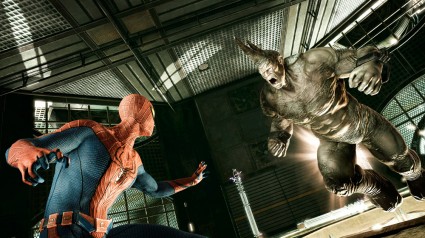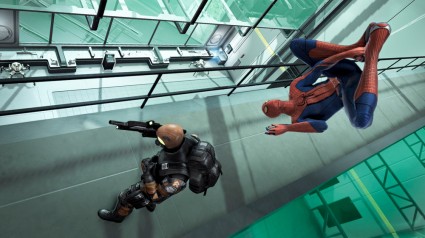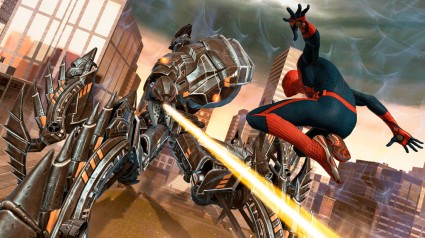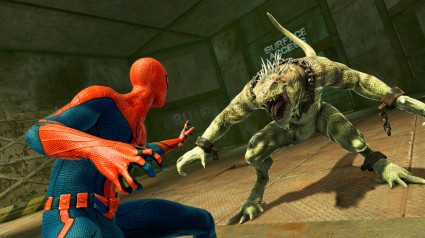Reviews
The Amazing Spider-Man
July 10, 2012, Author: Andy Corrigan
As the site’s resident Spider-Man fanboy, I have been fervently awaiting both the new Hollywood reboot, The Amazing Spider-Man, and its inevitable smash n’ grab video-game tie-in from Activision.
For the third time running, Beenox return to development duties for the Webhead, having had moderate success so far. They hit the ground running initially, providing a solid Spidey game in Shattered Dimensions, in spite of swapping the usual open-world playground for a structured affair. Unfortunately, their follow-up Edge of Time fared a lot worse, restricting things a little too much and leaving players with a hollow, repetitive experience that wholly disappointed.
With The Amazing Spider-Man tie-in, however, things have been looking back on track. Open-world New York returns in its starring role, while the much-touted Web Rush mechanic offers players a more precise and stylish way to navigate.
The movie, for me, totally hit the mark. Does the game follow suit or is this yet another weak-ass movie game, rushed out for a quick buck?
Monster mash!
In this particular movie tie-in, the action takes place just after the events of the film. Unfortunately in doing this, it drops a handful of major spoilers right from the off, so if you haven’t seen the film yet and want to check it out, don’t start this game until you’ve done so.
The obvious part that’s totally not a spoiler, though, is that the Lizard has been defeated, Peter and Gwen are trying to get on with their lives, and Oscorp have started purging the company of all their cross-species research. In charge of this operation is robotics specialist, Alistair Smythe; a name that Spidey fans should recognise instantly. With several dangerous specimens to dispose of, disaster is bound to happen. A handful of familiar genetic monsters escape, causing an infection in New York.
The main problem here is that the writing is nowhere near the quality of the movie, and it never really manages to match it in terms of tone. On a base level the plot gives you enough of an excuse to swing around New York pretending to be Spider-Man, but that’s all it is, never entertaining or excelling at any point as a piece of comic book/superhero fiction.

Spidey's about to get the horn...
Does whatever a Batman can…
So, open-world New York returns and, unless you’ve recently been playing Prototype 2, you’ll probably find it a refreshing experience to be web-slinging your way through the Big Apple once more. There have been some changes made to the way in which you get around, though.
In the previous open-world outings, Spidey’s web would realistically latch on to the nearest building and you would be stuck to it until you let go. To swing faster or higher you needed to have a basic understanding of momentum, and rounding corners and changing direction without smacking ungracefully into the side of a building took a little skill. It was very rewarding to master.
Here, though, Spidey will shoot webs and continue to swing for as long you hold the right trigger down, and the strands never physically attach to anything in particular. Once you hold that trigger down, the only thing you really need to worry about his direction or height; if you need to go higher, you simply hold the left trigger to elevate the next few swings.
While those webs don’t attach to buildings, Beenox have at least been conscious enough to make sure that you’re not swinging 30 feet above the Empire State Building. If there are no tall buildings around, you’ll at least fall until you’re low enough that it’s conceivable you’d be able to tag a building.
The positive side of this change is that you’ll never hit a building face first again, as the swinging between, over and around buildings always looks stylish. You’ll find that you’ll nearly always clear low buildings with swings, no matter how early or late you pressed to web swing. The game makes the necessary adjustments for you, making sure to put you at the right height.
If by a rare occurrence you do manage to hit a building, as long as you’re still holding that trigger, Spidey will seamlessly turn that momentum into a run up the building, using webs to keep his speed up. With this, the animation for Spidey never drops a frame when switching between mechanics, and you’ll end up performing some incredible looking manoeuvres as a result. It’s all the excitement and feeling of momentum from the previous system, but with none of the risk of looking like a fool. It’s a cheat, and a trick, but it’s one that works very well indeed.
When you combine it with Web Rush, navigating the city is an absolute joy. At any time you can hold the right bumper to slow down time and switch to a first person view. Here, for a short amount of time, you can look around at the highlighted points on which you can land, release and Spidey will automatically get you there in the quickest time possible. You can even use this system to trigger events and missions in advance, so that as soon as the Webhead lands, the event will start. You can attack enemies using this too, allowing you to rush in from a great distance and get that first attack in.
With both methods combined, you can create moments that look almost choreographed, especially in battle. I had an instance where I was against three Spider-Slayers in the city and was giving chase. In one of the swings forward I swung over a low building towards a taller building, and as I thought I’d misjudged the height of that second building, Spidey took three steps up the side and dramatically jumped off the lip. At this point I was at the perfect height to get in a Web-Strike on one of the robotic attackers, so I paused time, tagged them and made the attack, before landing on a flagpole and then giving chase again. It looked flawless in motion.

Spider-Man doing his best Batman impression...
So, at this point, you may be looking at the header above and be wondering where Batman might come into it. You’ll definitely notice the similarities when you’re thrust into enclosed areas where your only option is to fight, such as sewers and inside laboratories.
Just like Rocksteady’s work, you can wail endlessly on an enemy with the only attack button until another makes their move, which is when Parker’s Spider-Sense will trigger. When this happens, you’ll have a short window in which to hit the dodge button, which will see Spidey automatically counter.
Combat is mixed up thanks to a variety in enemies, such as shield-carrying goons that you need to vault and attack from behind, or gunmen that you must disable as a priority. Once you’ve hit an enemy enough, you’ll get an indicator that you can take them down for good with a finisher, either in the flow of combat or when they’re downed and dazed… it all sounds a little familiar, right? It’s quick, fluid and fun, but sadly not quite as satisfying as Batman’s own brand of brutality.
The similarities don’t stop there, as you can take Parker to the shadows of the ceilings and stalk your prey. Once on a wall or behind an enemy undetected and they’re within reach, you’ll be able to initiate a stealth takedown, before using the LB for a quick getaway. This is a system that Beenox already ripped off from Arkham Asylum when approaching the Spider-Man Noir sections in Shattered Dimensions, but it’s slightly better here, especially with some of the other mechanics (Web Rush and Web Retreat) allowing you to get in and out quickly and efficiently. It’s nowhere near as polished as in the Batman games, but there are some pluses, such as not having to be on a predetermined perch to be able to swoop.
Boss fights are unfortunately a massive let down. They’re the worst kind of formulaic and frankly, they’re dull, especially in sewer sections or against cross-species monsters. So, that’s most of them then. The fights against Alistair Smythe’s Spider-Slayers are at least grand in scale, if not remotely challenging or exciting in combat terms.
The Amazing Spider-Man has a very simple upgrade system in place. With every enemy defeated, every side quest completed or every person you help, you’ll earn XP to level up. When you hit a new level, you’ll be able to spend one point on new abilities, attacks and finishers. If you take down Oscorp robots, you’ll earn scrap that can be spent on tech upgrades, such as improving the strength of your web, or giving you perks against Oscorp’s robotic enemies. Both are simple but easy to use, and each choice makes a decent impact on how you want to play the game.
In-between story missions, you’ll have plenty to keep you occupied in the city, from minor deviations to meatier side-missions involving cross-species creations. Early on you’ll get photography quests, in which you’ll take photos of subjects in a particular area for a newspaper reporter, hinting at Spidey villains from the comic books. You’ll find out about secret Oscorp labs, which you can raid for more tech upgrades.
There are the typical mini-quests too, usually consisting of muggings, ending police stand-offs, and stopping getaway drivers by landing on their bonnets and webbing up their windows, avoiding gunfire in the process. You’ll have escaped mental patients to return to the cops, and infected civilians to get to quarantine zones. Unexpectedly for a non-Sam Raimi-related Spidey game, I’m delighted to say that Bruce Campbell also still has a part to play, this time as the Extreme Reporter, offering Spidey ‘extreme’ challenges to perform.
On top of all that, there are a whopping 700 comic pages to find as you play, which unlock full, classic comics for you to read in the extras menu.
Unfortunately, what lets the game down slightly is its repetition. Repetition in fights, repetition in stealth sections, and repetition in side-quests. Hell, it’s caused repetition in this paragraph.
That repetition isn’t necessarily a terrible thing in this case, as although each side-quest action in particular will forever be exactly the same as the last time you did it, there’s a really peculiar addictiveness in swinging endlessly around New York, being the hero and fulfilling these optional objectives.

I didn't picture Parker for a 'Slayer' fan...
Suit up!
The graphical run down of Amazing Spider-Man goes like this: Spidey looks and moves awesomely; everything else… not so much. The city of New York is boxy and blocky, NPCs move with stiff, awkward animations (even the key enemies), and all humanised character models look really eerie, especially in Gwen’s case… it’s all about the terrifying eyes! It doesn’t help that not one member of the movie’s cast has lent their likeness here either, so aesthetically the only connection it has to the movie is the costume.
Repetition creeps in visually too, with some sloppy design choices. For example, in the high-speed car chases that see you jump from car to car, there’s only ever one model of car involved, and that’s its only appearance. It’s baffling, but it symbolizes much about the game.
Still, it’s not totally without its charms. Swinging around New York City at night definitely has a certain appeal to it, especially with the foggy haze and neon lights helping the atmosphere feel that little more alive.
Thwip!
None of the film’s actors have stepped up to the microphone, and on the evidence of previous franchise’s movie tie-ins, with Tobey Maguire’s phoned in efforts, that might not seem to be such a bad thing. At second glance, however, it’s not that much of a plus point, either.
Sam Riegal takes on the role of the wall crawler in this instance, and while he’ll be adequate for most, he fails to make it his own. I’m sorry to say that for me, Spidey’s voice really outstayed its welcome pretty early on and I’d have much preferred to see Josh Keaton take on the role once more. The highlight, as he is in every game ever, is Nolan North as Alistair Smythe, followed closely by the legendary Bruce Campbell. None of the vocal talent (of which there’s some voice acting royalty on the list; Steve Blum, for example), are helped by a lifeless and only occasionally entertaining script.
Musically, the game does just about enough to create drama and suspense at the right times, but on the whole I found the entire soundtrack pretty forgettable.

Unfortunately for Spidey, the Iguana's special power isn't to stay really, really still and move only in short bursts...
Just swinging around…
Here’s the thing. Despite its flaws, despite the evident repetition, nearly everything contained in The Amazing Spider-Man video-game is fun to do. While the borrowed elements from Rocksteady’s work are unfortunately inferior to both Batman’s recent outings, they rarely get boring. Even the stuff that sounds the most mundane, like stopping petty crimes or carrying infected citizens a few blocks, remains fun after the umpteenth time you do it. Hell, killing 15 minutes just swinging around doing nothing in particular can be one of the game’s biggest pleasures.
While being fun doesn’t absolve it of all its faults, it does prevent The Amazing Spider-Man from being a typically rushed-to-market movie tie-in. If you’ve got nothing going on right now, you could do far worse than giving it a fair go.
Platforms: PC, PS3 | Tagged Alistair Smythe, Beenox, Free Roaming, Gwen Stacy, nolan north, Open world, Spider-Man, Spidey, The Amazing Spider-Man, The Lizard, Web Slinging, Webhead



